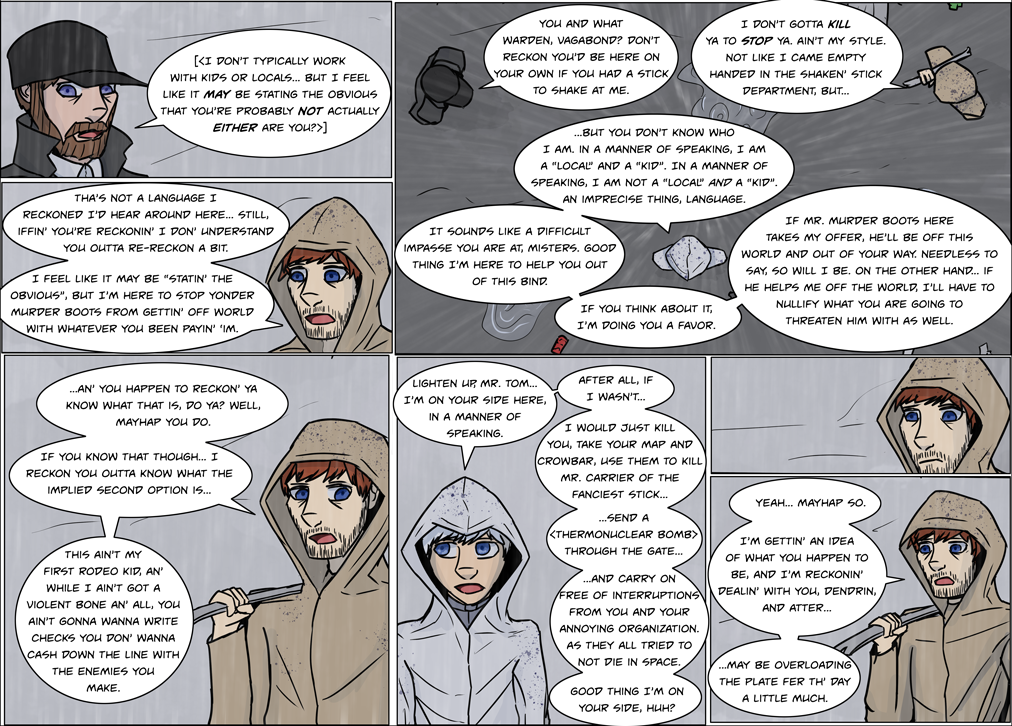Comic for Monday, August 9th, 2021
…Does Vium actually have a nuke? Who knows. After all, he’s speaking… hypothetically. In what he said, the part that Tom probably took as the most significant part is what he revealed he knows, rather than any implied threat (how capable Vium is of any of that should not necessarily be taken for granted… after all, it’s not like he’s threatening anyone… he’s purely speaking in… hypotheticals), but that he even knows what a nuclear bomb is would recategorize who he could be.
Something both Tom and Vium would know is that the Central gates were originally much more isolated from the Central seats of power, but increasingly Central has put more important things closer to their gates, because it’s convenient for them (for several reasons), and they didn’t necessarily expect anyone to have access to their gates. This is another thing that is less the direct threat, and more the implication that he seems to know an awful lot about Central that a very short list of people would know.
Of course, I think we’ve seen before that while Mium tends to avoid violence, he is not entirely unfamiliar with idea of risk reduction plans. He is just prevented from implementing them. If he actually would if he was able to is something that I think everyone is just as happy not figuring out. Mium is capable of realizing that would be how to reduce risk (annihilating the element of risk completely) but Mium is capable of nuanced understanding. I say Mium because we know more about Mium then Vium more than that because they are entirely interchangeable, but I will say that we should have a pretty good grasp of Vium’s personality based on what he is.
As folks were discussing the difference between Bridgepoints and Gates in the comments yesterday, I figure I can answer that here where more folks will see it than if I replied to the comment, though folks mostly had the difference correct. A gate is basically a “transfer”. All the contents of a designated area are transferred from one world to another another. A Bridgepoint is more like a “tunnel”. You go in one side in one world and come out the other side in the other world. Westley Roberts and Tgape had it pretty much correct the difference.
One additional wrinkle for those that pay attention to the magic system, there’s a flaw with a Bridgepoint that should make them essentially impossible; but that’s not a plot hole… that’s the reason the are difficult to make. If they seemed possible, Central would just be able to make one, as they have figured out how to make gates, and how to travel between worlds.





I really liked it when we had the nice little legends under the comic telling us what each language is. The author may reasonable suspect that we’ve seen these often enough to keep track of the really odd ones and the really common ones.
Unfortunately, I have the memory of an over-caffeinated goldfish when it comes to certain details. . . I’m going to guess that Mr. Murder-boots/Dendrin was speaking Korish, or possibly Orish, to hide what he was saying from Tom, which language use suggests his lack of compunction.
Yay!
Of course I wouldn’t mind a Tuesday Friday comic schedule since I just lost one of those. 🙂
Page will be up tomorrow.
Does Vium have what ILA refers to as Mium’s defect of not being able to kill directly? Perhaps Mium wants another “free agent” to do what he cannot.
He couldn’t kill that Kardus, so he had that defect then – but I’m not sure if he might be more unrestricted since being shunted into a system of his own.
Moreover, he speculated that none of his restrictions would hold “in the face of [his] current irregular decision capabilities”, so even if he still is restricted, I suspect it’s only because he hasn’t decided otherwise.
Neat?
I’ve always found it interesting that Mium can violate his restrictions, but seems to choose not to even when it gets the chance.
If I’m right about it being the explanations of why the restrictions are there, then Vium says he knows his way around the restriction, because he’s found a technical exploit he know will work. Mium might even know the same exploit.
But the thing is, Mium doesn’t, because the explanation’s sound. And thus, neither of them will kill anyone… until Vium happens across a curious little village that’s so cut off from the rest of the world, they haven’t spoken to anyone from outside their village in generations.
Vium won’t act fast. He’ll be careful and thorough and make sure that it really is the case. But once he has… nobody will ever know they existed.
This, incidentally, includes us. Past won’t put up an update to even show us the village, because even Past is unaware of them. If Past *did* know about them, that would be one person too many, and VIum wouldn’t touch them.
I find it interesting that Tom is apparently planning on dealing with Atter today….
OH! So many thoughts to chew on.
On the subject of gates & wormholes & tunnels: there as so many options for the mode of transport and type of “experience”… so many of them are prone to flaws: personally I like the instantaneous kind: if it’s a gate, you step through and you are there, but then the link closes; if it’s a tunnel you step through and are there and the link remains open: it’s the bent piece of paper (“flatland”) with a hole poked through it option. Honestly I think most visual Sci-Fi have some kind of a whooshing tunnel to imply to the viewer distance travelled (I blame warp drive in Star Trek)… but really it’s not necessary. Of course the catch with this is the energy required to fold space until two points touch must be… oh wait: I can do it to “flatland”… so maybe from the right perspective it’s not to hard to do the real space??? From a writing perspective: if we ignore the ridiculous energy requirements, instantaneous travel fixes the frame-of-reference problems that everyone (usually) forgets about.
As for the wrinkle… do I smell “Eidos key”??? To have a stable bridge would require one right? Otherwise you’d need a rotating shift of mages to maintain the connection. Considering we’ve never seen mages do anything co-operatively… oh wait we DID see several help Eliana have enough power to create her Dragon: but that’s not really passing on a calculation to someone else to continue.
As for conservation of energy… I don’t remember if it’s ever been explicitly stated if it is: I have kind of assumed it is conserved, even for magic: most of my evidence is from the way you need to collect power to fuel your calculation (the little red dots around mages when they are casting!). So while calculation speed is important: so is the ability to collect power: something which we see Kally is impressively good at (so Kally is never short of power for her dragon: meanwhile Eliana needed five mages to help her power her dragon (well until Atter took control)). Magic just lets you do things that make conservation of energy seem not to matter: but only because you haven’t include “magic energy” in the equation. I suppose the only thing open here is how do mages power their ability to collect magic energy? (I.e. how much effort does that require (and I assume it varies depending on how much magical energy is available to start with)). Oh! Perhaps this is what the Eidos key allows you to do: magical energy manipulation with only the power of thought!
I forget the source, but I recall one sort of wormhole type gate where ones perception of the travel was instantaneous, despite the ends of the touching actually touching – or, for that matter, actually being connected.
From the perspective of the sending end, the person(s) were just gone, so there wasn’t really anything to measure the speed of travel by. From the perspective of the receiving end, it usually took a few minutes. However, there wasn’t any perception of when the person actually *entered* the gate, just “we started this process at x time, and at x+00:09:47, the target arrived.”
The experience of the target did vary a bit, if one looked at it from a “how long from the gate opening until stepping through” perspective, in which case it varied from a few seconds to a few hours. That amount of time didn’t seem to have any effect on how long it took on the receiving end.
More on that bit about not actually connected… there was clearly something there to cause the wormhole to *usually* transport the right entity, because most of the time, it worked exactly correctly. The rare case when it did not, however, it generally didn’t fail just a wee bit. It wasn’t clear if the target may have been taking a stroll in some other dimension, but what was clear was what went through was not from the target’s home.
I seem to have a one or two words out of my comment. Specifically, the first paragraph is missing two ‘not’s. It feels like where those were supposed to go should be fairly obvious.
More thoughts on that source; if I recall correctly, it did specifically thank Barbra Hambly. I don’t recall if it mentioned a specific work, but the only one of hers I remember reading that went into depth on gate behavior was The Windrose Chronicles. The wormhole gates in the work were notably different in the aspect that passing through the gates did not leave any impression of passage of time, and there seemed to have been a lower incidence rate of ancillary gates.
That said, the Windrose Chronicles specifically mentioned opening a gate on or near a ley line increased the incidence rate of ancillary gates, as well as increasing the range at which those gates could happen. Also, all of the gates I remembered being opened in the Windrose Chronicles were opened on or near a ley line, and I only recall a couple whose locations were mentioned that weren’t opened at a ley line nexus, because after all, why limit your world destruction to a few hundred square miles when you could wreak havoc to thousands or hundreds of thousands of square miles. (All magic was easier on a lay line The number of mages who could open gates entirely away from any ley lines was limited. or even more at a nexus. Some mages who couldn’t normally cast magic could do it with difficulty at a nexus. This was a plot point for one of the books.)
FYI – I went to look up who Vium is (cause I have no idea where they came from), and found the wiki appears to be broken 🙁
Exception encountered, of type “Error”
Thought you might like to know.
Chapter 13 October 25, 2018 through November 1, 2018 is our introduction to Vium, not the first time Vium is seen in comic, but the explanation of who or what he is and how he differs from Mium is first explained. How Vium gets his very own body is explained after that at some point, very interesting stuff.
I definitely recommend rereading the entire comic once every six months or so. I, personally, don’t, but I, definitely, recommend it.
The author knows the wiki, it was in a comment awhile back. They’ll try to fix it at some point, but are too busy currently. I miss it too.
We finally have an idea about what tom’s crowbar dose. It rips open a tear in reality under someone, and his map allows him to connect that portal with a list of pre-calculated places. The map has coordinates and perhaps temporally valid velocity info for the gate near central station as well as for wherever he uses as a prison or marooning place.
As for the difference between a gate and bridgepoint is not in energy use because magic dose not respect conservation of energy. Instead calculation speed is the limiting factor. That can also explain why some diminutions are closer than others as the target planet(s) are in the same arm of a analogous galaxy thus on a more predictable coarse.
I think you’re on to something with the GPS comment. Mostly in the motion front. We know that it takes either computers or a pathfinder to run a gate without everyone being transported dying. Which means that enough variables are constantly changing that it’s not simple. This makes sense, because motion of planets, or space stations, is complicated and translating between the two precicely while negating the velocity difference precisely is not an easy task.
The bridgepoint would have to do that in real time. Referencing another fictional setting, Stargates get around the issue by using a buffer system. The entire object goes in, is sent as a unit, then comes out the other side. Of course, Stargates also canonically work like Star Trek transporters in the whole digitize and re-construct thing, but the general buffer systemitself could work.
I have the idea that Mium’s more prohibited by the argument against terminal risk reduction plans than he is by the prohibition against them at this point. It’s one of those areas where Peter has extended the useful life of his SMAI by actually explaining things, rather than interacting with it as minimally as possible.
I’d guess that Peter thought through the consequences of those sorts of plans a bit further than most people, but not nearly as far as Mium has. Peter took it to his exhaustion point – which was somewhere after he realized it would basically extend to conflict with people from virtually every country. Mium probably took it to the point where he realized not only would it require killing all the humans on Palindra, but every world they interacted with, and every world they interacted with, and so on. And that includes Kor’s World, because they have a thing against SMAIs, and if Mium did enough killing to get anywhere close to that goal, he’d have their full attention.
Just to restate what I thought I read about gates and bridgepoints here… A gate isn’t really ‘opened’, per se. The other end is located and tracked as I had thought. But it’s basically like a transporter; to activate it is to move things. It takes a significant pulse of mana to do that, probably directly proportional to some measure of what is being moved, though not necessarily linearly. That measure could be mass in Hyle, mass in Eidos, combined Hyle and Eidos mass, plot significance, or a bunch of other things. Eidos keys could have a distinct contribution to the cost or not.
A bridgepoint, on the other hand, is a pipe. There’s a cost to open and maintain the pipe, but depending on what exactly is put through and how, there may not be a cost to pump through it. But it’s possible there could be. Depending on how much it costs to open and maintain, it could be much more efficient to actively pump the stuff through. In the case of people, that could be we set up the bridge point just off a couple of highways, and we redirect traffic to drive through at more or less the local speed limit. But it could also be pick stuff up with magic and fling it through.
As far as the flaw that should make them impossible – that’s what the people of Central thought about them, until Kor’s World made it clear they could make them. I think this is similar to how there’s this issue that should make GPS navigation systems impossible, except that we figured it out with a bunch of smart scientists like Heisenberg, and so we have them. (Or is it that they had been much simpler to make until the archmages Einstein and Heisenberg convinced enough people that the world worked differently in such a way that GPS navigation systems should be impossible to make?)
The word ‘tunnel’ adds a set of questions, however: how *long* is this tunnel, in terms of experience? This is a set of questions, because there’s a bunch of different perspectives, and they could have different answers. I’m reminded of one tale in which there was a transporter where the perspective of the people who went in the transporter was it took a few hours. The people outside the transporter perceived it taking a few thousand years or negative a few thousand years, depending on which direction they went. Except, if people start trying to cite the reference for that tale, we’ll find out there’s a bunch of them that could be. And others that are just off by timescale.